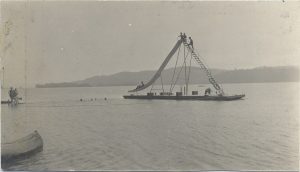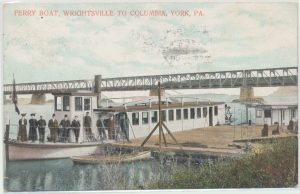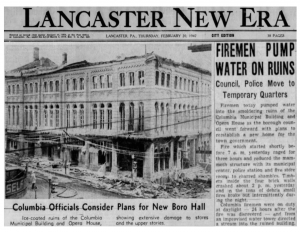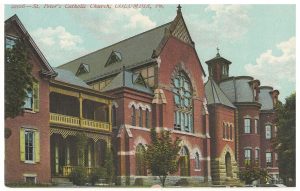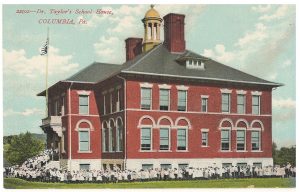Columbia’s Storied Places
Columbia’s Storied Places
|
|
|
|
Uncover Columbia’s many stories in our new exhibit at Columbia Crossing River Trails Center. Historic photographs, postcards, and newspaper clippings make up a scrap book of our town. We’ve covered Columbia first 200 years, but we need you to share your memories of the last century. Did your grandfather remember construction of the Veterans Memorial arch bridge? Did you attend Manor or Poplar Street Schools? Maybe your parents remember JFK giving a speech near the Rising Sun. Come read and contribute to the stories of Columbia.
Each generation of Columbia residents has transformed the town to meet their own needs. Thousands of Columbians have left their marks, large and small. Susquehanna National Heritage Area’s new exhibit at Columbia Crossing, created with the support of the Columbia Historic Preservation Society and Lancaster History, is a celebration of Columbia’s “storied places.” We explore how the borough’s iconic locations, from the industrial riverfront to the ornate but ill-fated opera house, evolved and changed over Columbia’s long history.
The first part of the exhibit focuses on two areas of Columbia: the riverfront and the center of town. Each generation used these spaces differently. In the late 18th century, the ferry, lumbering, and shad fishing were the primary riverfront activities. Before the Civil War, the railroad and canal industries made Columbia a hub for the transportation of raw and consumer goods. In the early 20th century, the Pennsylvania Railroad opened a Recreation Park at the riverfront, complete with a floating water slide!
The center of town became the cross of 3rd and Locust Streets. The first town hall and market opened there in 1814. After the Civil War, the booming city of Columbia decided to award building contracts for a new Town Hall and Market House. These were to be a showcase of Columbia’s great prosperity – and they were. The Market House stands at nearly 10,000 square feet because of the amazing curved Howe trusses in the roof. The three story Town Hall with a 140 foot tall clock tower was the real showpiece. It had retail space, town government offices, and a 1,000 seat opera house. Actors and plays from New York City regularly visited. Only 75 years later, it succumbed to a tragic fire.
There are two other long-standing edifices in the town of Columbia: churches and schools. These buildings have been central to the community since its founding. The Old Columbia Public Grounds Company used land rents to fund education for Columbia’s children as early as 1837. Although the first church of Columbia – a Meeting House – no longer exists. The second church of Columbia built in 1807 still stands between 3rd and 4th on Walnut Street. The diversity of the churches in Columbia truly showcases the great diversity of our community for nearly 300 years.
But, we can only scratch the surface; to really tell the stories of this place, we need your help. We invite you to add your story about a special building or place in Columbia. We will display the stories in the public exhibit and then in a digital map once the exhibit closes.
Columbia Crossing owned by the Borough of Columbia and is managed by Susquehanna National Heritage Area (SNHA). SNHA works to showcase the river’s natural, recreation, and history stories to make this region a national destination for outdoor fun and cultural discovery. Visitor hours of the center are Tuesday – Saturday 10 AM – 4 PM, Sundays 12 PM to 4 PM through Memorial Day.

